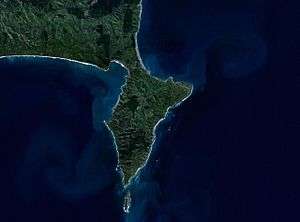Ngāti Rongomaiwahine
Ngāti Rongomaiwahine or Rongomaiwahine is a Māori iwi (tribe) traditionally centred in the Mahia Peninsula on the North Island of New Zealand.[2] In the 2006 census, 4,254 people identified as Rongomaiwahine;[3] by the 2013 census, this has increased to 4,473 people.[1] It is closely connected to the Ngāti Kahungunu iwi.[4][5]
| Ngāti Rongomaiwahine | |
|---|---|
| Iwi (tribe) in Māoridom | |
 Mahia Peninsula from space | |
 | |
| Rohe (region) | Mahia Peninsula |
| Waka (canoe) | Kurahaupo, Takitimu |
| Population | 4,473 (c. 2013)[1] |
| Website | http://rongomaiwahine.iwi.nz/ |
The people of Rongomaiwahine are descended from a common ancestor, Rongomaiwahine. She was descended from Ruawharo, the tohunga (navigator) of the Tākitimu waka (Māori migration canoe) , and Popoto, the commander of the Kurahaupō waka.
In Māori tradition, Rongomaiwahine was known to have had two husbands: Tamatakutai and Kahungunu. With Tamatakutai, she bore two daughters, Rapuaiterangi and Hinerauiri. With Kahungunu (well known as the eponymous ancestor of Ngāti Kahungunu) she bore five children: Kahukuranui, Rongomaipapa, Tamateakota, Mahakinui and Tauheikuri.[5]
Historically, Rongomaiwahine have operated successful whaling stations. Today, fishing remains an important industry, along with the operation of sheep and cattle stations. Rongomaiwahine Iwi Trust (RIT) is the administrative body of the iwi.[2][4]
Marae and wharenui
Peninsula marae
Te Atihau was the tribe's traditional marae (meeting ground).[2] The ground is now part of farming station of designated Māori freehold land which Rocket Lab uses to launch satellites.[6][7]
The iwi is also associated with three other marae and wharenui (meeting houses) on the peninsula:
Inland marae
The iwi is associated with four marae and wharenui north of the peninsula:
See also
- List of Māori iwi
References
- Whaanga, Mere (26 September 2006). "Ngāti Rongomaiwahine". Te Ara – the Encyclopedia of New Zealand. Archived from the original on 19 August 2007. Retrieved 29 June 2007.
- "Iwi Profiles (Individual)". www.stats.govt.nz. Retrieved 25 January 2016.
- "Mahia - Rongomaiwahine". Rongomaiwahine. Retrieved 8 November 2016.
- "2006 Census – QuickStats About Māori (revised)". Statistics New Zealand. 4 April 2007. Archived from the original on 28 September 2007. Retrieved 25 May 2007.
- "Te Puni Kōkiri iwi profile". tkm.govt.nz. Te Puni Kōkiri, New Zealand Government. Retrieved 29 May 2018.
- Whaanga, Mere. "Te Ara iwi profile". Te Ara: The Encyclopedia of New Zealand. Retrieved 29 May 2017.
- Treacher, Aroha (9 February 2016). "Tawapata South Inc signs multi-million dollar deal with Rocketlab". Te Kaea. Māori Television. Retrieved 5 June 2018.
- Ashton, Andrew (26 January 2018). "Maori 'chuffed' to host launch of Star Rocket Lab's new Humanity Star". Hawke's Bay Today. NZME. Retrieved 5 June 2018.